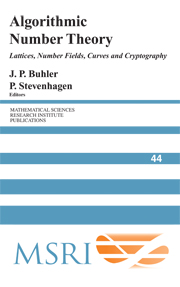Book contents
- Frontmatter
- Contents
- Preface
- Solving the Pell equation
- Basic algorithms in number theory
- Smooth numbers and the quadratic sieve
- The number field sieve
- Four primality testing algorithms
- Lattices
- Elliptic curves
- The arithmetic of number rings
- Smooth numbers: computational number theory and beyond
- Fast multiplication and its applications
- Elementary thoughts on discrete logarithms
- The impact of the number field sieve on the discrete logarithm problem in finite fields
- Reducing lattice bases to find small-height values of univariate polynomials
- Computing Arakelov class groups
- Computational class field theory
- Protecting communications against forgery
- Algorithmic theory of zeta functions over finite fields
- Counting points onvarieties over finite fields of small characteristic
- Congruent number problems and their variants
- An introduction to computing modular forms using modular symbols
Smooth numbers: computational number theory and beyond
Published online by Cambridge University Press: 30 May 2025
- Frontmatter
- Contents
- Preface
- Solving the Pell equation
- Basic algorithms in number theory
- Smooth numbers and the quadratic sieve
- The number field sieve
- Four primality testing algorithms
- Lattices
- Elliptic curves
- The arithmetic of number rings
- Smooth numbers: computational number theory and beyond
- Fast multiplication and its applications
- Elementary thoughts on discrete logarithms
- The impact of the number field sieve on the discrete logarithm problem in finite fields
- Reducing lattice bases to find small-height values of univariate polynomials
- Computing Arakelov class groups
- Computational class field theory
- Protecting communications against forgery
- Algorithmic theory of zeta functions over finite fields
- Counting points onvarieties over finite fields of small characteristic
- Congruent number problems and their variants
- An introduction to computing modular forms using modular symbols
Summary
The analysis of many number theoretic algorithms turns on the role played by integers which have only small prime factors; such integers are known as “smooth numbers”. To be able to determine which algorithm is faster than which, it has turned out to be important to have accurate estimates for the number of smooth numbers in various sequences. In this chapter, we will first survey the important estimates for application to computational number theory questions, results as well as conjectures, before moving on to give sketches of the proofs of many of the most important results. After this, we will describe applications of smooth numbers to various problems in different areas of number theory. More complete surveys, with many more references, though with a different focus, were given by Norton [1971] and Hildebrand and Tenenbaum [1993a].
This article has two target audiences. For those primarily interested in computational number theory, I have tried to write this paper so that they can better understand the main tools used in analyzing algorithms. For those primarily interested in analytic problems, I have tried to give concise introductions to simplified versions of various key computational number theory algorithms, and to highlight applications and open counting questions. Besides the danger of never quite getting it right for either reader, I have had to confront the difficulty of the differences in notation between the two areas, and to work with some standard concepts in one area that might be puzzling to people in the other. Please consult the appendix for notation that is non-standard for one of the two fields.
This article is not meant to be a complete survey of all progress in this very active field. Thus I have not referred to many excellent works that are not entirely pertinent to my view of the subject, nor to several impressive works that have been superseded in the aspects in which I am interested.
Information
- Type
- Chapter
- Information
- Algorithmic Number TheoryLattices, Number Fields, Curves and Cryptography, pp. 267 - 324Publisher: Cambridge University PressPrint publication year: 2008
Accessibility standard: Unknown
Why this information is here
This section outlines the accessibility features of this content - including support for screen readers, full keyboard navigation and high-contrast display options. This may not be relevant for you.Accessibility Information
- 20
- Cited by
